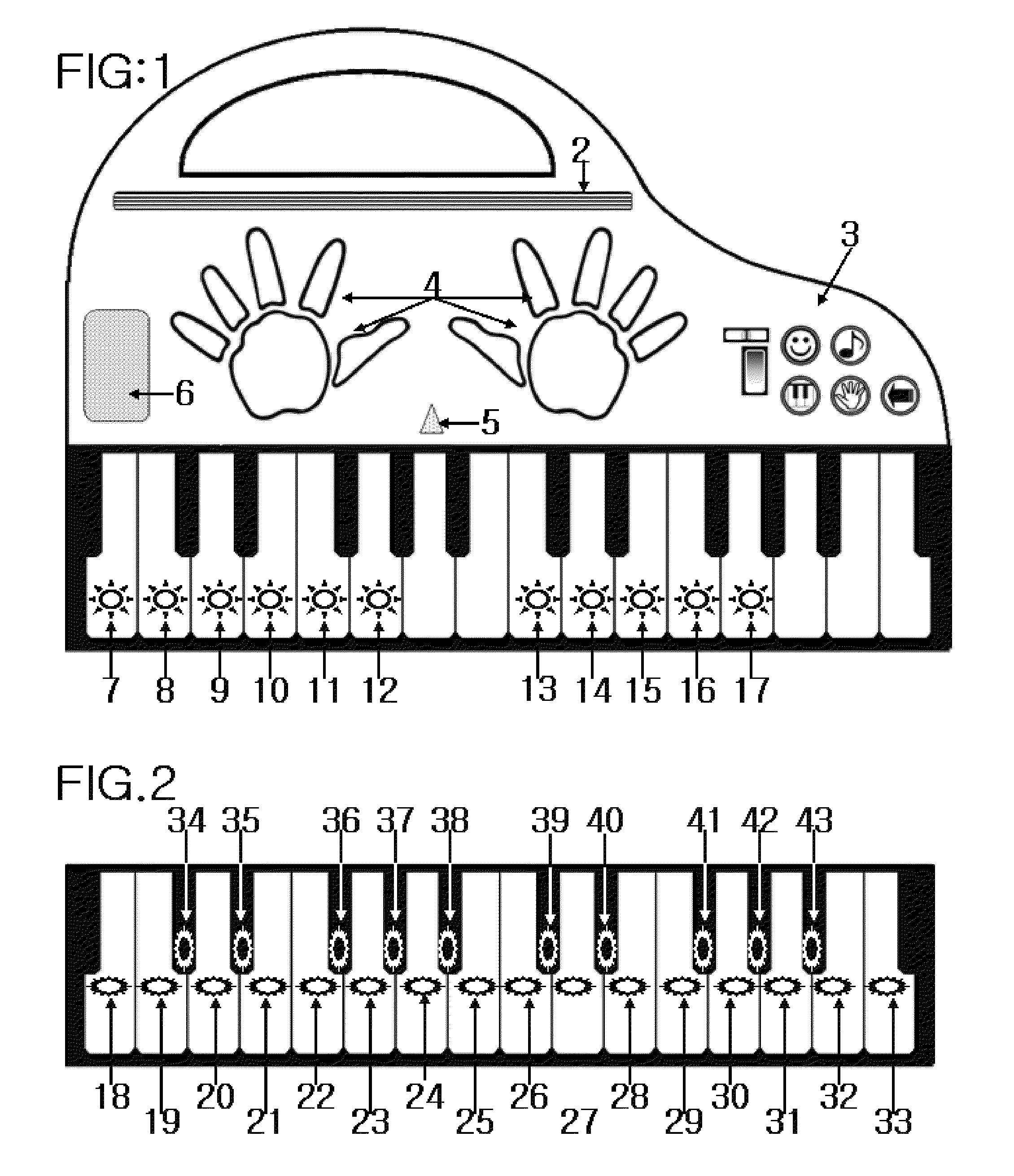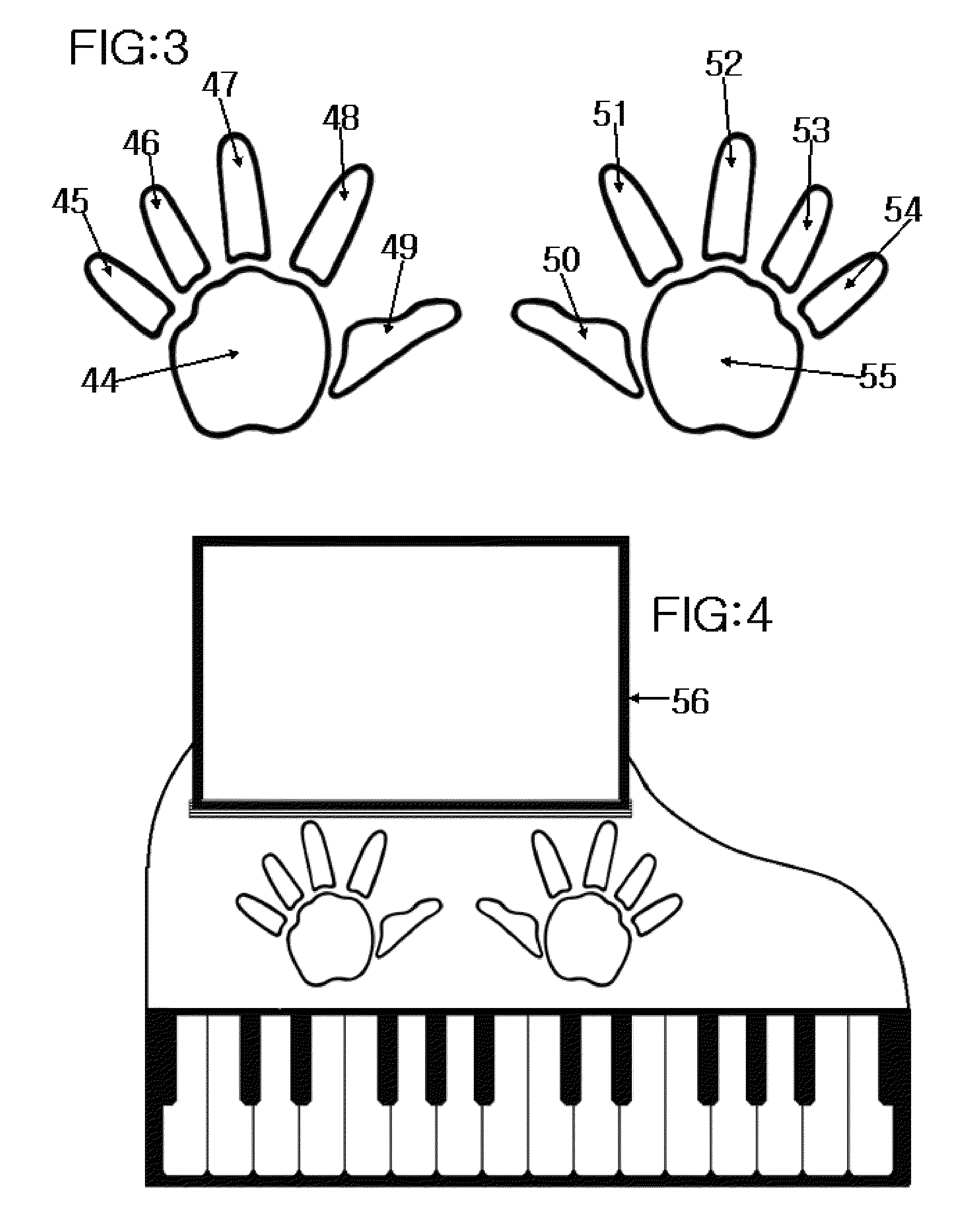[0018]The inadequacies of prior art are addressed by this apparatus. This is a comprehensive, complex teaching apparatus driven by an
electronic circuit operated program. It requires no instructional supervision, it requires no prior knowledge of playing a keyboard
musical instrument; it requires no ability to read notation; it begins at the most elementary level, enabling a beginner with no prior experience to learn to play a
piano / keyboard; it utilizes multi-sensory stimuli not found in any prior art; and allows the user to move from the very elementary level of learning, moving one finger at a time, to the ability to use
all fingers and to accurately read and respond to standard music notation, thereby establishing the basis of lifelong musical skills.
[0020]Each of the defined shapes of the hands has a light, such as LED, positioned underneath, able to illuminate shapes singly or jointly when activated. Right hand fingers and left-hand fingers are color-coded to each other. The vibration mechanism is able to activate a vibration effect associated with each finger shape or shapes singly or jointly. A set of
colored lights or colored lenses are positioned underneath a minimum of eleven white keys to enable the keys to be illuminated in the same five colors as the finger shapes, one particular color per key. An additional set of lights which are all uniform color, one light under each key, enable keys of apparatus to be illuminated singly or jointly. An
electronic circuit controls the operation of the electronic learning device utilizing verbal prompts to the user, different colors in the hands and / or keys, the vibrating mechanism, sound accurately pitched to 440A, and displays on the screen, in order to instruct the user how to play a musical keyboard instrument and read standard music notation.
[0022]Instruction begins with audio, visual, and tactile sensory prompts. As user progresses, the helpful sensory prompts are gradually decreased until user is able to respond accurately without any additional sensory helps. Instruction begins by prompting the user to place his / her hand onto the palm and finger shapes, matching each finger to the corresponding finger shape. User is then instructed to depress a particular illuminated, vibrating finger shape with user's corresponding finger. When user responds correctly to this action, user is prompted to move his / her hand to the keyboard and depress an illuminated / vibrating key with user's finger that corresponds to illumination of the corresponding finger shape as well as the illumination on the key. Instruction progresses from user's ability to respond correctly to the instruction for one finger on the finger shape and key utilizing each finger of both hands, to sequences of fingers on the finger shapes and keys. Every action includes two or more of the sensory instruction or sensory stimuli: verbal instruction, properly pitched sound, visual color and tactile vibration. When the user progresses to play sequences or songs utilizing the second set of lights which are all the same color to illuminate the keys, the apparatus continues in its instruction by teaching the user how to read music notation. This instruction, as with all the other functions of this apparatus, utilizes sensory stimuli: verbal instruction, properly pitched sound, visual color and tactile vibration, thereby eliminating the need for the user to be able to comprehend written letters or words in able to learn to read music notation. As the user gains proficiency, the sensory helps are gradually withdrawn, making it possible for the user to play on any piano / keyboard without the multi-sensory instructional aides. The user is always recognized for correct responses and gently encouraged to repeat an activity in order to correct errors.
[0024]As each new function is added, actions are built on skills learned in beginning activities. This allows user to proceed with new, more difficult functions combined with already familiar actions, functions and activities and to proceed with instruction limited to one new step at a time.
[0025]This apparatus and method makes it possible for the user to learn to play the piano / keyboard in a confident, non-intimidating way, independently without the need for instructional supervision. This apparatus may be used by a very young user, one as young as two years old. The instruction however, is also suitable and appropriate for an older user. Methods of instruction appropriate for young learners can be used for older learners, but methods of instruction appropriate for older, reading learners cannot be used for young learners. Instruction in this apparatus is steadily progressive to keep the user's interest.
 Login to View More
Login to View More  Login to View More
Login to View More 


